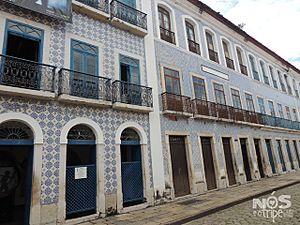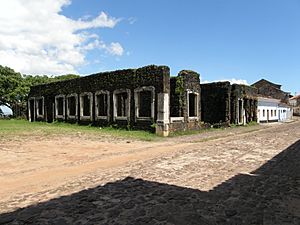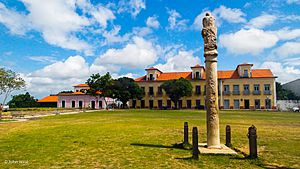Brazilian cotton cycle facts for kids
Quick facts for kids 
Historical Center of São Luís
|
|
| Duration | From the 18th to the 19th century |
|---|---|
| Location | Maranhão and Pernambuco, Brazil |
| Participants | Farmers, slaves, and the Portuguese
|
| Outcome | Economic expansion of the Captaincy of Maranhão; increase in slavery in Maranhão, and demographic changes |
The cotton cycle was a time when cotton became super important in Brazil's economy. This happened mostly in Maranhão between the mid-1700s and early 1800s. It brought a lot of economic growth to the area. During the colonial period, cotton was also grown in other parts of Brazil, like Captaincy of São Vicente. From there, it was sent to places like Rio de Janeiro and Bahia. Other regions grew cotton to make clothes for local use, especially for enslaved people.
This period of cotton growth happened during a tough economic time in the colony. The "gold cycle" was ending, and sugar from Brazil faced strong competition from sugar grown in the Antilles. Also, the Industrial Revolution was starting, and the United States War of Independence meant less cotton was coming from America, which was a big supplier to England.
Contents
Before the Cotton Boom
Early Economy in Maranhão
In 1621, the Philippine dynasty (Spanish rulers who also ruled Portugal at the time) created the State of Grão-Pará and Maranhão. This huge area included parts of what are now Maranhão, Ceará, Piauí, Pará, and Amazonas. It reported directly to the Portuguese crown.
The main ways people made money here were growing sugar and tobacco, raising cattle for their hides, and collecting cocoa. Most people in this region were very poor. They lived by gathering food, fishing, and growing just enough food for themselves (called subsistence agriculture).
Economic Challenges and Conflicts
By the mid-1600s, Maranhão faced money problems. After the Dutch were kicked out of the Northeast of Brazil, the local sugar business struggled. It was too expensive to bring in enslaved people from Africa. Also, sugar from the Antilles was cheaper.
During this time, Father António Vieira was important. In the 1650s, he was in charge of the Jesuit Missions in Maranhão. He set up rules for the missions: preaching, baptism, and education. These followed Portuguese culture and the rules of the Council of Trent.
There were disagreements between farmers and the Jesuits. The Jesuits tried to stop farmers from using enslaved indigenous people for labor. The Jesuits asked the Portuguese King for help. The King agreed and banned the enslavement of indigenous people. This was because it didn't make money for Portugal.
To fix the problems, the King created the Maranhão Commerce Company in 1682. This company had control over all trade in Maranhão for 20 years. It had to bring 10,000 enslaved Africans (500 each year). It also had to sell them at set prices. The company also supplied European goods like textiles, cod, wine, and flour. In return, the company had to send at least one ship a year from Maranhão and another from Grão-Pará to Lisbon with local products. Things like cocoa, vanilla, pau-cravo wood, and tobacco could only be sold to this company at fixed prices.
The company couldn't keep its promises. This made the economic problems worse and made people in the region very unhappy. This led to conflicts, like the Beckman's Revolt. The revolt was stopped, and the King later closed the company.
The Pombal Period
New Companies and Changes
In 1755, the Marquis of Pombal, a powerful minister in Portugal, created the Grão Pará and Maranhão Company. This company was supposed to make sure enslaved Africans came to the colony. It also controlled all shipping and foreign trade. The company also offered loans to local farmers and introduced better farming methods. Later, Pombal also kicked the Jesuits out of all Portuguese colonies.
In 1772, Pombal divided the large state into two smaller parts. These were the State of Maranhão and Piauí (with its main city in São Luís) and the State of Grão-Pará and Rio Negro (with its main city in Belém).
Cotton Takes Off
There was a growing need for cotton, which was a key material for England's textile factories. Also, the United States stopped exporting cotton because of its War of Independence, which started in 1776. These events caused the colony's economy to grow a lot. France was also an important buyer of cotton from Maranhão.
Cotton had been grown in Maranhão since 1661, but mostly for local use. Between 1760 and 1771, cotton exports from Maranhão jumped from 651 to 25,473 arrobas (a unit of weight). The number of ships arriving in São Luís each year grew from three to twenty-six by 1788.
Cotton's Expansion
By 1780, cotton made up about 24% of Brazil's exports. Sugar was still bigger, at about 34%.
In 1818, Maranhão's economy was worth one million pounds. It handled 155 ships, making it Brazil's fourth largest economy. At this time, São Luís was the fourth most populated city in Brazil. The beautiful mansions in the Historical Center of São Luís and Alcântara show how rich the area was then. Cotton made up between 73% and 82% of Maranhão's exports in the late 1700s and early 1800s.
About 83.70% of Brazil's cotton exports came from Grão-Pará, Maranhão, and Pernambuco (which included Paraíba).
Between 1791 and 1801, Brazilian cotton made up 40% of all the cotton sold in Liverpool, which was the main market for the product.
Slavery and its Impact
Between 1756 and 1788, about 30,000 Africans were brought to Belém and São Luís. About 70% of them came from Guinea, and the rest from Angola.
By 1798, enslaved people made up 47% of the population. This number grew to 55% in the early 1800s. The white population was only 16%. In the Itapecuru valley, the number of enslaved people reached 80%.
Using enslaved labor was a huge reason for the cotton cycle's success in Maranhão. It caused big changes in the population and society of the colony. These changes, like major social inequality, continued even after slavery was abolished.
Cotton's Decline

After 1820, the United States started selling cotton again on the world market. They had better farming methods and produced more. This made Maranhão's economy lose its strength. Cotton prices dropped by 70%.
In the years that followed, coffee became the most important product in Brazil's economy and its main export.
Maranhão became economically and socially unstable. There were conflicts like the Balaiada (1838–1841). This was a movement by common people against the rich landowners.
During the American Civil War (1860–1865), Maranhão had a short period of economic growth again. But it soon declined in the following decades. It also had to deal with the end of the slave trade to Brazil, then the movement of enslaved people between different parts of Brazil, and finally, the end of slavery completely.
See also
- Brazilian cacao cycle
- Brazilian sugar cycle
- Brazilian coffee cycle
- Amazon rubber cycle
- Brazilian Gold Rush


